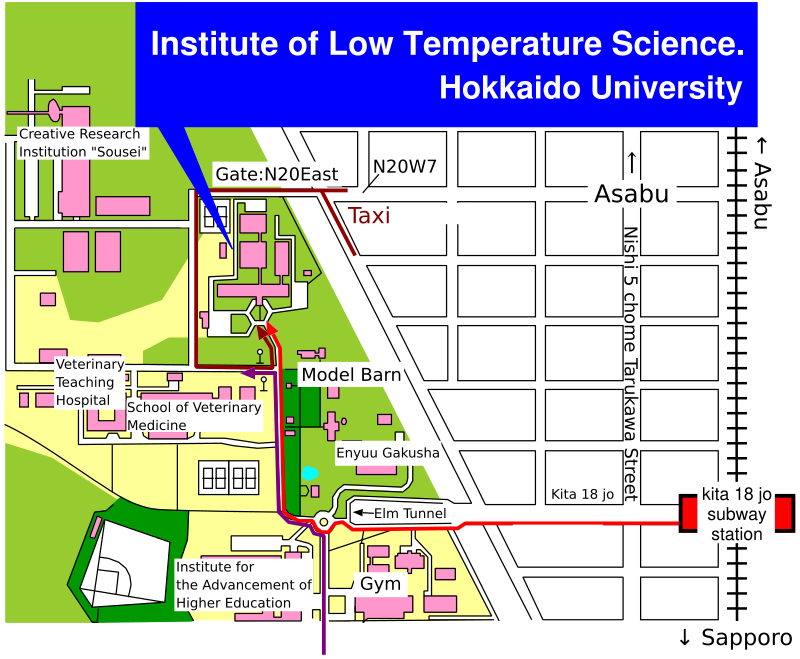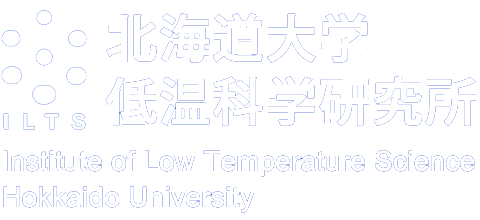About ILTS
Greeting from the Director

The Institute of Low Temperature Science (ILTS) was founded in 1941 as the first research institute affiliated with Hokkaido University. Since then, the ILTS has achieved development in the areas of basic studies on snow and ice, and natural sciences in the cryosphere and cold environments. In 2010, the ILTS was designated as a Joint/Use Research Center aiming for "Fundamental and applied researches of scientific phenomena in cold regions with climatic low temperatures" by the Ministry of Education, Culture, Sports, Science and Technology (MEXT), Japan. In April 2022, the designation as a joint/use research center was successfully extended.
We understand that role of a university-affiliated joint/use research institute is to launch unique, creative, and long-range research projects under cooperation with domestic and international partners. Considering the importance of cryosphere in the Earth climate system, we have conducted inter- and multi-disciplinary researches in the cold regions, including the Pan-Okhotsk Sea area adjoining to Hokkaido, the Antarctic and the Arctic. In addition, fundamental studies in low-temperature physics and chemistry, geochemistry, planetary science and biological environment science have produced unique and outstanding achievements. Considering the research fields that the ILTS covers, the size of the institute is not large enough. However, we aim to develop interdisciplinary researches irrespective of conventional study fields, to promote research projects with domestic and international partners, and to create new research communities. We would appreciate your further supports and encouragements.
April 2024
Director of the Institute of Low Temperature Science, Naoki Watanabe
History
The Institute of Low Temperature Science (ILTS) was founded in 1941 as the first research institute affiliated with Hokkaido University to promote interdisciplinary studies on various natural phenomena occurring in the cryosphere. The ILTS owes its establishment to the achievements of Professor Ukichiro Nakaya, the first person in the world to create artificial snow crystals. In 1995, the ILTS was reorganized as a nationwide joint-use institute to promote the fundamentals and applications of various natural phenomena occurring in the cryosphere. The ILTS was reorganized again in 2008 and is now composed of three research divisions (Water and Material Cycles Division, Frontier Ice and Snow Science Division and Environmental Biology Division), Joint Research Division and Pan-Okhotsk Research Center. In 2010, the ILTS was approved as a nationwide joint-use institute and a networking hub of academic exchanges with various research communities.
see also: Low temperature science: the past, present, and future
| 1941 | Establishment of ILTS as the first research institute of Hokkaido University Opening of Physics, Meteorology, Biology, Medical, Applied Physics and Oceanography Sections |
| 1963 | Opening of Section of Snow Disaster Science |
| 1964 | Opening of Frost Heaving Section |
| 1965 | Opening of Monbetsu Sea Ice Laboratory |
| 1966 | Opening of Section of Frost Injury in Plants |
| 1968 | Relocation to the present site completed |
| 1970 | Opening of Snow Hydrology Section |
| 1973 | Opening of Biochemistry Section |
| 1975 | Expansion of a research building |
| 1981 | Opening of Section of Snowfall Mechanism |
| 1991 | Closing of Section of Snowfall Mechanism Opening of Section of Cryo-climatology |
| 1995 | Reorganization of the ILTS as a nationwide joint-use institute Opening of Marine and Atmospheric Science Section, Cryospheric Science Section, Basic Cryoscience Section, and Boreal Environmental Sciences Research Section |
| 1997 | Completion of a new laboratory building |
| 2000 | Completion of a new research building |
| 2003 | Start of renovation of old buildings |
| 2004 | Closing of Monbetsu Sea Ice Laboratory Opening of Pan-Okhotsk Research Center in Sapporo campus |
| 2008 | Completion of renovation of old buildings Organizational reformation of the ILTS Opening of Joint Research Division, three research divisions (Water and Material Cycles Division, Frontier Ice and Snow Science Division, and Environmental Biology Division) |
| 2010 | Approval as a nationwide joint-use institute and a networking hub of academic exchanges with various research communities |
International Exchanges
| Countries | Counterparts | Concluded |
|---|---|---|
| Germany | Center for Synthetic Microbiology, Philipps-Universität Marburg | November 27, 2023 |
| Germany | Faculty of Life Science and Technology, Berlin University of Applied Sciences | February 17, 2023 |
| Ukraine | Sumy State University | July 13, 2020 |
| South Korea | Korea Polar Research Institute | June 24, 2019 |
| France | Observatoire de Paris | March 20, 2019 |
| Portugal | Instituto de Tecnologia Química e Biológica António Xavier, Universidade Nova de Lisboa | February 5, 2019 |
| Germany | Leibniz Institute for Baltic Sea Research, Warnemünde | November 30, 2018 |
| China | College of Bioscience and Biotechnology at Yangzhou University | July 19, 2018 |
| Norway | The Faculty of Mathematics and Natural Sciences, University of Oslo | July 13, 2017 |
| U.S.A. | The Department of Chemistry at the University of Hawaii at Manoa | February 6, 2017 |
| U.S.A. | The Regents of the University of California on behalf of its San Diego campus's Scripps Institution of Oceanography | March 17, 2016 |
| Spain | Agencia Estatal Consejo Superior de Investigaciones Científicas | January 19, 2016 |
| Italy | University of Milano-Bicocca | December 4, 2015 |
| Norway | Depertment of Geosciences, University of Oslo | February 16, 2015 |
| Russia | Pacific Geographical Institute, Far Eastern Branch of Russian Academy of Sciences | March 7, 2014 |
| Russia | Far Eastern Regional Hydrometeorological Research Institute | March 27, 2013 |
| Russia | North-Eastern Federal University | April 2, 2012 |
| France | CNRM - GAME URA 1357, Météo-France - CNRS | March 26, 2012 |
| Danmark | Niels Bohr Institute, University of Copenhagen | January 25, 2012 |
| Germany | Max-Planck Institute for Terrestrial Microbiology | January 19, 2012 |
| Sweden | Faculty of Science, Stockholm University | September 20, 2010 |
| Germany | University of Bremen | February 11, 2010 |
| Russia | Far Eastern Branch Russian Academy of Science | July 23, 2009 |
| South Korea | Center for Space-Time Molecular Dynamics at Seoul National University | June 30, 2009 |
| Germany | Max-Planck Institute for Marine Microbiology | March 4, 2009 |
| Germany | Alfred Wegener Institute for Polar and Marine Research | March 3, 2009 |
| Australia | University of Tasmania | January 9, 2009 |
| 17 Universities and Institutions from 12 Countries | International Antarctic Institute | November 21, 2007 |
| Russia | Far Eastern Federal University | November 12, 2007 |
| Switzerland | Swiss Federal Institute of Technology Zurich (ETH) | June 13, 2007 |
| China | Nankai University | May 11, 2006 |
| Finland | University of Oulu | December 11, 2001 |
| U.S.A. | University of Alaska | December 20, 1986 |
Access
Institute of Low Temperature Science, Hokkaido University
Kita-19, Nishi-8, Kita-ku, Sapporo, 060-0819, Japan
From Chitose Airport to Sapporo JR Railway Station
JR, Bus or Taxi.
Access Guide Site: New Chitose Airport Access Guide
by JR
From Chitose Airport Station, take "Kaisoku Airport" for Sapporo. It takes about 40 minutes and costs 1,230 yen for one way. It departs every 10 minutes during daytime.
by Bus
Airport busses run almost every 30 minutes during daytime between the center of Sapporo and the Chitose Airport. It takes about 80 minutes depending much on traffic conditions. It costs 1,300 yen one way.
From the Sapporo JR Railway Station
Subway or taxi.
by Subway
Take the Namboku Line bound for Asabu from the Sapporo subway station (N06), and get off at the 2nd station, the Kita 18-jo station (N04). It costs 210 yen one way.
by Taxi
About 1,300 yen (winter +20%), and takes about 10 minutes.
MAP
- Sapporo Campus Map
- Circumference map

Contact us
Institute of Low Temperature Science, Hokkaido Univ.
Kita-19, Nishi-8, Kita-ku, Sapporo 060-0819, Japan
About research activities, please inquire of each research groups.
If you have any comments or suggestions about this website, please send us an email on www-admin@lowtem... (please replace "lowtem..." with "lowtem.hokudai.ac.jp").
Links
- Hokkaido University
- Hokkaido University Researchers' Directory
- Institute of Low Temperature Science
- Graduate School of Environmental Science
- Graduate School of Science
- Arctic Research Center
- International Antarctic Institute
- Council for Research Institutes and Centers of Japanese National Universities

- The Council of Joint Usage/Research Centers in National Universities

